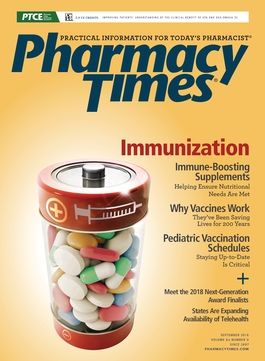News
Article
Pharmacy Times
The Evolution of Pharmacy Technicians: Traditional and Emerging Advancement Opportunities
The growth of pharmacists’ roles across health care settings has led to the need for a comparable evolution in the responsibilities and roles of pharmacy technicians.
The growth of pharmacists’ roles across health care settings has led to the need for a comparable evolution in the responsibilities and roles of pharmacy technicians. Traditionally, technician tasks have focused on cashiering, insurance claim processing, medication preparation, and order entry, usually within a community or hospital setting. Advancement opportunities have been limited to lead technician or supervisory roles, medication and supply purchasing, and sterile products compounding because of a lack of promotion opportunities.
However, the recent shift of pharmacists’ roles toward direct patient care has created a void that technicians have an opportunity to fill.1
With the growing use of clinical pharmacy services, technicians have been increasingly called on to take responsibility for both clinical and operational functions across all patient-care settings.
Clinical tasks include:
- Conducting medication reconciliation across all patient care areas
- Delivering bedside medication
- Facilitating medication therapy management2
- Gathering clinical monitoring information for pharmacy-run clinics
- Preparing home infusions
Operational functions include:
- Dispensing prescriptions with remote video pharmacist supervision
- Managing inventory and floor stock
- Managing pharmacy informatics
- Performing prescription monitoring program database searches
- Performing remote data entry of prescriptions for pharmacist verification
- Providing call center support for medication received by mail order
- Providing insurance formulary guidance
Although technicians have made great strides in their profession, these advancements have slowed primarily because of inconsistent state requirements and a lack of formal, standardized education for pharmacy technicians. Forty-five states and Washington, DC, have regulations establishing certification, licensure, or registration requirements for technicians, but these requirements vary from state to state. As of January 2017, just 24 of those states and the District of Columbia required national certification.3
In early 2017, the Pharmacy Technician Certification Board (PTCB) held a national stakeholder meeting to develop industrywide consensus on qualifications and standards for advanced practice and entry-level technicians.4 Attendees drafted recommendations for the advanced practice certification, education, entry-level requirements, and regulation of technicians. As a result of this meeting, the Accreditation Council of Pharmacy Education (ACPE), the American Society of Health-System Pharmacists, and the PTCB have implemented more stringent and uniform requirements regarding certification, education, and continuing education for technicians, with new standards for ACPE accreditation and PTCB certification taking effect in January 2019 and January 2020, respectively.5,6 The PTCB has also developed a second certification program focused specifically on sterile compounding.7
In addition, many states are updating the rules and regulations concerning permitted technician duties. For example, the Idaho Board of Pharmacy recently updated its rules to allow certified pharmacy technicians to administer immunizations, clarify and transfer prescriptions, and take verbal orders, as long as key requirements—national certification and proper training—are met.8
Despite the lack of consistency regarding technician standards, national and state regulatory organizations have worked diligently to increase their presence on their respective boards. Arizona, Massachusetts, Montana, Oregon, Puerto Rico, Texas, Utah, Washington, and Wyoming have at least 1 technician on their state board of pharmacy.
There is still much work to be done, the roles of technicians have come a long way, and further expansion is likely on the horizon. This will continue to broaden technician advancement opportunities and increase clinical and operational specialization, allowing technicians to play an even more vital role on the pharmacy team.
LeAnn Bolster, CPhT, is a technician at the Boise VA Medical Center in Idaho and is the former director and chair of technician affairs for the Idaho Society of Health-System Pharmacists.Megan Koyle, PharmD, BCPS, BCACP, is a teleprimary care clinical pharmacy specialist at the Phoenix VA Health Care System in Arizona.
References
- Evolving pharmacy technician roles open new doors, pose new regulatory challenges. Innovations. nabp.pharmacy/wp-content/uploads/2016/07/Innovations_April_2017_Final.pdf. Published April 2017. Accessed July 31, 2018.
- Fuerst M. Pioneer MTM center supported by certified pharmacy technicians. PTCB website. ptcb.org/about-ptcb/news-room/news-landing/2011/09/20/pioneer-mtm-center-supported-by-certified-pharmacy-technicians#.W19AX2a0VPY. Published September 20, 2011. Accessed July 31, 2018.
- Pharmacy technician state regulations. PTCB website. ptcb.org/resources/cpht-toolkit/state-regulations#.W18wjWa0VPY. Accessed July 31, 2018.
- Pharmacy technician stakeholder conference. PTCB website. ptcb.org/about-ptcb/pharmacy-technician-stakeholder-consensus-conference#.W1-iama0VPY. Accessed July 31, 2018.
- Revised ASHP/ACPE accreditation standards for pharmacy technician education and training program (revised): frequently asked questions. ASHP website. ashp.org/-/media/assets/professional-development/technician-program-accreditation/docs/ashp-acpe-revised-pharmacy-technician-program-accreditation-standards-faq.ashx?la=en&hash=20A4F63D3DBD66AFA487CEC39978674392F343B9. Published July 2018. Accessed July 31, 2018.
- Important updates to the PTCB CPhT program in 2020. PTCB website. ptcb.org/about-ptcb/certification-program-changes#.W1-xmGa0VPY. Accessed July 31, 2018.
- Become a PTCB certified compounded sterile preparation technician (CSPT). PTCB website. ptcb.org/get-certified/cspt#.W1-w12a0VPY. Accessed July 31, 2018.
- Idaho State Board of Pharmacy news. National Association of Boards of Pharmacy website. nabp.pharmacy/wp-content/uploads/2016/06/ID032017.pdf. Published March 2017. Accessed July 31, 2018.







